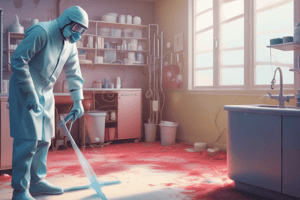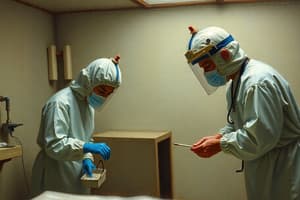Podcast
Questions and Answers
What does sterilization specifically eliminate?
What does sterilization specifically eliminate?
- Vegetative pathogens
- All viable microorganisms, including viruses (correct)
- All harmful microbes
- Only bacterial endospores
Which of the following correctly describes bacteriostatic agents?
Which of the following correctly describes bacteriostatic agents?
- They prevent the growth of bacteria (correct)
- They kill all microorganisms
- They promote microbial growth
- They are used as disinfectants
What is microbistasis?
What is microbistasis?
- The process of completely sterilizing an object
- The permanent death of microorganisms
- Temporary prevention of microbial multiplication (correct)
- The reduction of microbial load in living tissues
What is the main purpose of sanitization?
What is the main purpose of sanitization?
Which statement about microbial death is correct?
Which statement about microbial death is correct?
Flashcards
Contaminants
Contaminants
Microorganisms present at a location or time that are considered undesirable or unwanted.
Sterilization
Sterilization
The process that eliminates all viable microorganisms, including viruses.
Disinfection
Disinfection
The process using physical or chemical agents to destroy vegetative pathogens, but not bacterial endospores.
Antiseptics
Antiseptics
Signup and view all the flashcards
Microbial Death
Microbial Death
Signup and view all the flashcards
Study Notes
Chapter 11 Notes
- Contaminants are microbes present at a place and time that are undesirable or unwanted
- Decontamination methods employ physical or chemical agents
- Microbes are categorized into 3 resistance groups:
- Highest resistance
- Moderate resistance
- Least resistance
- Sterilization destroys/removes all viable microorganisms (including viruses):
- Can't be almost sterile, it either is or isn't
- Stasis/static means to stand still
- Microbistasis is when microbes are temporarily prevented from multiplying, but not killed
- Disinfection uses a physical or chemical agent to destroy vegetative pathogens, not bacterial endospores
- Antiseptics are applied directly to exposed skin
- Sanitization removes debris, soil, microorganisms, and toxins from surfaces
- With living tissue, reducing microbial load through mechanical means is called degermation
- Chemical/physical agents damage microbes at the cellular/molecular level
- Microbial death is the permanent loss of reproductive capacity, even under optimal conditions
- Surfactants reduce surface tension of cell membranes
- Microbial function depends on an orderly/continuous supply of proteins
- Any chemical blocking this process affects function and survival.
Studying That Suits You
Use AI to generate personalized quizzes and flashcards to suit your learning preferences.




